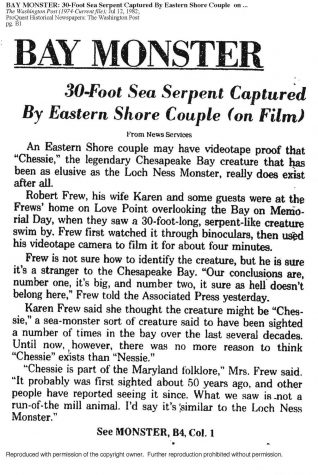The Unsolved Chesapeake Bay Mystery
Artist tim Sheirer’s representation of deer swimming in the Bay. He reports: “A few years back I came upon, what I considered, an interesting explanation for Chessie sightings. When I was employed at St. Mary’s City Historic Park I worked with Bill Trosbeck (not sure of the spelling) who, with his brother, were Watermen. Bill told me the story of being out on the bay one early morning as the sun was just rising over a very calm water. They both observed a male white-tailed deer followed by several doe swimming across a narrower point of the bay. The silhouetted image through the rising mist could quite easily have been interpreted as the head and undulating body parts of a serpent-like creature. I mimicked that image as a very small part of a large mural in the Calvert Marine Museum.”
The year is 1943. The water feels eerily peaceful on a river beside Baltimore. Two fishermen, Edward W. and Francis Klarrman, are sailing over the Bay with a smile on their faces. It’s a great day to make some profit out of the abundance of fish that swim through the area. However, in their expedition to rake in some cash, the two men spot something… strange.
It was described as a 12-foot-long serpentine creature not too far away from their vessel. Its head was the size of a football, and almost horse-like. It kept looking back at the two of them, turning its neck around – almost all the way around – many times.
What exactly was going on here?
Well, in all actuality, this is entirely up to speculation. The creature they claimed to have spotted is none other than Chessie, our very own Chesapeake Bay cryptid. In case you were unaware, a cryptid is a creature presumed to be real that hasn’t quite been proven yet.

An assorted group of people has described Chessie differently, but there are a lot of things that the reported sightings have in common – plenty of them describe a long, black, snake-like creature.
Based on how bizarre a diverse group of people has described Chessie, along with the fisherman’s description of the beast, it would only be normal to assume that this was fake news. But… is it really? Just how false are the claims of a reptilian lurking in the depths of our very own Chesapeake?
Some of the very first sightings of the sea monster have been reported to go back as far as 1846, when a man known as Captain Lawson saw something strange at the tip of the bay.
All sorts of people have claimed to have spotted the beast here and there, from retired CIA officers to fishermen to soldiers to just plain old ordinary civilians. Plus, several people have pointed it out as being much more plausible than its Loch-Ness cousin.
“Those who believe in Nessie the monster of the Loch Ness, point to the astounding depths of the loch to account for how the creature can hide,” writes Khristina Gaddy. “It’s easy to imagine what creatures might hide in the largest estuary in North America.”

And this is very true – on top of the Bay being so large in comparison to the Loch-Ness Lake, there are a ton of other fascinating features that might point to the possible existence of Chessie – in fact, the Chesapeake is 204 times larger than the lake. Especially considering how much larger the Loch Ness Monster is typically portrayed, it really could boost the chances of something like our monster being hidden away
Additionally, there is an abundance of different animals that end up in the Bay, here and there, that you might never expect! Sharks and manatees have both shown up within the bay’s waters, too. So, who’s to say an unidentified creature couldn’t either?
So, is Chessie real? Well, as of right now, it’s completely up to speculation. While they have debunked some myths and false photos on the serpent, nobody really knows for sure if it’s out there or not.
One thing’s for sure, though – it sure makes for an interesting report.






